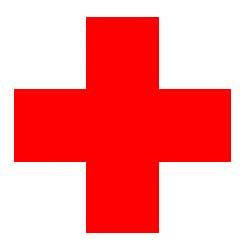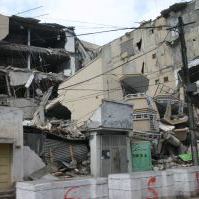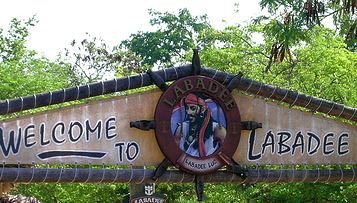 Recovery efforts are continuing and rebuilding efforts are just starting in Haiti. The death toll is more than 150,000 and everyone still needs your help.
Recovery efforts are continuing and rebuilding efforts are just starting in Haiti. The death toll is more than 150,000 and everyone still needs your help.
Just because it’s not on the front pages anymore, doesn’t mean it’s not still front-page news.
Over the weekend, Peter spoke with Jonathan Aiken of the American Red Cross in Washington, DC.
Peter Greenberg: How are things going over there in Haiti?
Jonathan Aiken: We’re doing quite well. Compared to two weeks ago, there has been a big improvement of how things are going on the ground.
PG: You’re getting more supplies and shipments in, but is the port reopened yet?
 JA: The port is partially reopened. In fact, we’re getting conflicting reports about that. Some of the folks on the ground are telling us better news than what we’re hearing from the official channels. That prompted us to change some of our strategies in terms of getting material over. Some of the material that can come in the second and third waves of relief we’re now sending in by ship. It’s actually cheaper to do that and we can get more material onboard.
JA: The port is partially reopened. In fact, we’re getting conflicting reports about that. Some of the folks on the ground are telling us better news than what we’re hearing from the official channels. That prompted us to change some of our strategies in terms of getting material over. Some of the material that can come in the second and third waves of relief we’re now sending in by ship. It’s actually cheaper to do that and we can get more material onboard.
PG: The last time we talked, you had about $21 million in aid just from people texting 90999. Where is it now?
JA: Just over $30 million from the texting alone, and $187 overall.
PG: But it’s not enough.
JA: Well, it’s a really great start. We want people to help and if texting is the easiest way for people to do that, it’s great. Whatever they donate to us goes into what will no doubt be medium and long-term recovery for this country. In fact, we have a team on the ground now—apart from our relief group—which is deploying today and heading up a multi-national assessment of the country’s long-term needs. They’re doing this with the American Red Cross and working with the Haitian government, the World Bank, the United Nations, and the Interamerican Bank which is providing a lot of money.
Avoid wasting your efforts with Haiti Disaster Scam Warnings
 PG: With all due respect to what’s going on in Haiti, you said you’re working with the Haitian government. Up until recently, there WAS no Haitian government. There wasn’t much of an infrastructure there, was there?
PG: With all due respect to what’s going on in Haiti, you said you’re working with the Haitian government. Up until recently, there WAS no Haitian government. There wasn’t much of an infrastructure there, was there?
JA: The government has been working on the mend and has been trying to get out from beneath itself. Literally. Even before the earthquake this country was compromised in many ways. The Haitian government has been working quietly, and some would say too quietly, to work more with agencies around the world—predominantly the UN, the World Bank, and other governments in order to get some organization off the ground. The leadership is working ahead to what comes next. And that’s where we start. It’s not so much that we’re starting with the bureaucrats and the ministers; we’re working with the people on the ground who are delivering supplies and who know the infrastructure really well. We’re literally starting this assessment from the ground up.
Can tourism help Haiti? Haiti Earthquake: Helping Haiti Travel & Tourism
 PG: One of the cruise lines, Royal Caribbean, caught a lot of flack for continuing its itinerary to its private Haitian beach called Labadee. Even though it brought hundreds of pallets of aid, I think the symbolism of people with piña coladas stuck up their noses on the beach in the middle of a relief effort didn’t really help their PR efforts. Have you had any interaction with the cruise lines to see how they can help you?
PG: One of the cruise lines, Royal Caribbean, caught a lot of flack for continuing its itinerary to its private Haitian beach called Labadee. Even though it brought hundreds of pallets of aid, I think the symbolism of people with piña coladas stuck up their noses on the beach in the middle of a relief effort didn’t really help their PR efforts. Have you had any interaction with the cruise lines to see how they can help you?
JA: Not that I’m aware of. It doesn’t mean it hasn’t happened. Royal Caribbean has partnered with us in the past on projects.
PG: I don’t want to abuse their intentions but the demonstration of those intentions really got them in trouble. I would think Royal Caribbean could dedicate a cruise ship—much like they did after Hurricane Katrina—where you could anchor it off the coast, put in three times the number of people that would normally stay on a cruise ship, hot bunk them in eight-hour shifts, and tender them to shore. That could really put them to good use instead of sailing to an outer island and saying we’re helping the economy because we’re buying alcoholic drinks.
Learn more: Cruise Ships in Haiti: Right or Wrong?
JA: I can’t speak to what Royal Caribbean is doing and I wouldn’t even presume to try. I think that’s best handled by the folks in Miami and Fort Lauderdale.
 PG: I don’t blame you for not speaking, but that’s my job. I’m going to dump on them now. The bottom line is when you have all this excess capacity in the cruise industry, it would seem to be a wonderful opportunity for them to dedicate at least one ship and not worry where the revenue is going to come from. Especially considering how much money they make every year from stopping in countries like Haiti.
PG: I don’t blame you for not speaking, but that’s my job. I’m going to dump on them now. The bottom line is when you have all this excess capacity in the cruise industry, it would seem to be a wonderful opportunity for them to dedicate at least one ship and not worry where the revenue is going to come from. Especially considering how much money they make every year from stopping in countries like Haiti.
JA: One of the problems is how do you get that relief off when the ports aren’t working as well as they could be? I’m not saying this in defense of any cruise line or company, but we have found that we had to offload offshore some of the material we brought in. The first assumption was the port is open, we came on in, and it wasn’t.
PG: I understand that, but a cruise line is perfectly positioned to use all their tenders to at least get relief workers onshore. In fairness to Royal Caribbean, they have committed at least $1 million in humanitarian relief, as have Disney, NCL, Carnival. I just think from a public relations point of view, they didn’t serve themselves well by doing shore activities on Labadee when everything else was going on.
To donate to the American Red Cross, text the word “Haiti” to 90999, visit www.redcross.org, or call 1-800-RED-CROSS ((1-800-733-2767).
Related links on PeterGreenberg.com:












